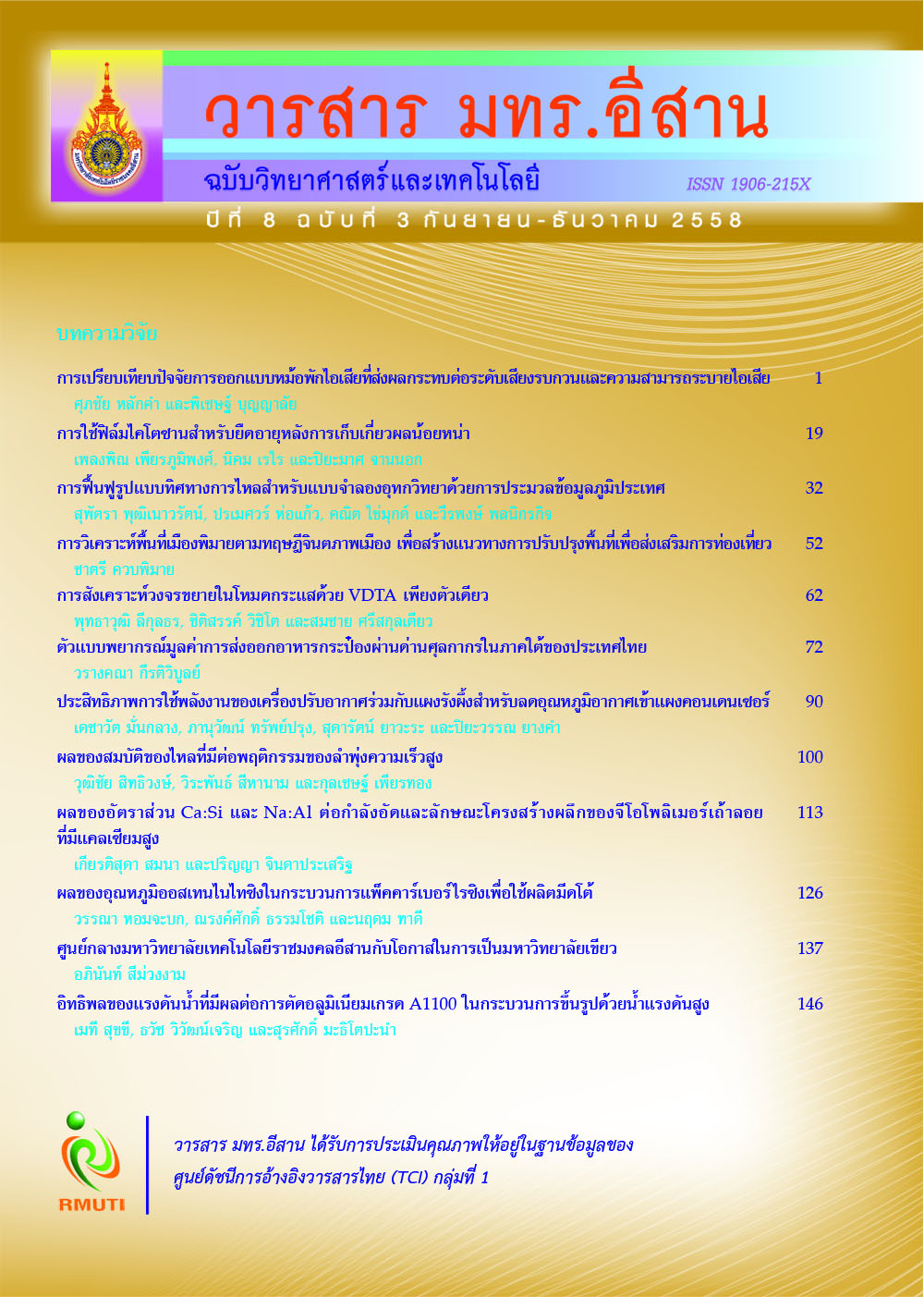ผลของสมบัติของไหลที่มีต่อพฤติกรรมของลำพุ่งความเร็วสูง Effect of Liquid Properties on High Speed Liquid Jets Behavior
Main Article Content
Abstract
บทคัดย่อ
งานวิจัยนี้มีวัตถุประสงค์เพื่อศึกษาพฤติกรรมของลำพุ่งความเร็วสูงและคลื่นกระแทก (Shock Wave)
ของเหลวที่มีสมบัติต่างกัน ประกอบด้วย นํ้า (Water) นํ้ามันดีเซล (Diesel Fuel) และนํ้ามันสบู่ดำ
(Jatropha Curcas Oil) ที่กำเนิดจากหัวฉีดเครื่องยนต์ดีเซลแบบเดือย (Pintle Nozzle) ขนาดรูฉีด
(Orifice) 0.8 mm ด้วยวิธี Projectile Impact Driven (PID) ผลการทดลองบันทึกด้วยกล้องถ่ายภาพ
วิดีโอความเร็วสูง (High Speed Video Camera) ร่วมกับเทคนิคชาร์โดว์กราฟ จากการทดลองพบว่า
ความเร็วเริ่มต้นของนํ้ามันดีเซลมีค่าสูงสุดประมาณ 850 m/s และนํ้ามันสบู่ดำมีความเร็วเริ่มต้นประมาณ
250 m/s นอกจากนี้จากภาพถ่ายเห็นพฤติกรรมของลำพุ่งของเหลวและคลื่นกระแทกชัดเจน รูปทรงของ
ลำพุ่งนํ้าแตกต่างจากลำพุ่งของนํ้ามันดีเซลและนํ้ามันสบู่ดำ กรณีคลื่นกระแทกของนํ้ามันสบู่ดำจะแตกต่าง
จากกรณีอื่นคือการเกิดคลื่นกระแทกเป็นแบบ Multiple Shock Wave
Abstract
The aims of this research are to study high velocity liquid jets and shock wave
behavior of liquids with different properties. The liquid examined in this research
consisted of water, diesel fuel and jatropha curcas oil, and High velocity liquids
jets were generated using the projectile impact driven (PID) method along with
a pintle diesel engine nozzle with a 0.8 mm orifice diameter. The experiment
results were recorded by using a high speed video camera and shadowgraph
technique. From experimental results, it is found that the diesel fuel liquid jets
have the highest initial velocity of about 850 m/s while the jatropha curcas oil has
the lowest initial velocity of about 250 m/s. According to recorded data, high velocity
water jets differs in shape and behavior from diesel fuel and jatropha curcas oil jets.
This and other liquid jet and shock wave behavior are clearly illustrated in
recorded data. As a result, multiple shock waves are generated from jatropha curcas
oil with high velocity liquid jets. This is in sharp contrast to the liquid jets creating
with diesels fuel and water.
Article Details
References
PhD. Dissertation. School of Engineering. University of Brighton.
Nakahira, T., Komori, M., Nishida, M. and Tsujimura, K. (1992). The shock wave
generation around the diesel fuel spray with High pressure injection. SAE.
Vol. 101. No. 3. pp. 741-746
Sik Lee C., Obara T. and Park S.W. (2002). An experimental and numerical study on fuel
atomization characteristics of high-pressure diesel injection sprays. Fuel. Vol. 81.
Number. 18. pp. 2417-2423
Park S.W. and Lee C.S. (2003). Macroscopic structure and atomization characteristics
of high-speed diesel spray. International Journal of Automotive Technology.
Vol. 4. pp. 157-164
Payri R., Salvador, J., Gimeno, J. and de la Morena (2009). Effcets of nozzle geometry on
direct injection diesel engine combustion process. Applied Thermal Engineering.
Vol. 29. No. 10. pp. 2051-2060
Sittiwong W., Pianthong K., Seehanam W., Matthujak A. and Kasamnimitporn C. (2011).
Effect of test chamber conditions on the cehavior of high speed diesel jets.
Journal of Science & Technology. Ubon Ratchathani University. Vol. 13. No. 1.
pp. 97-108
Sittiwong W., Pianthong K., Seehanam W., Matthujak A. and Kasamnimitporn C. (2011).
Effects of temperature on the high speed liquid jets behaviors. Journal of
Science & Technology. Ubon Ratchathani University. Vol. 13. No. 2. pp. 33-43
Bakar R. A. and Ismail A. R. (2008). Fuel injection pressure effect on performance of
direct injection diesel engines based on experiment. American Journal of
Applied Sciences. Vol. 5. Issue 3. pp. 197-202
Pianthong, K., Matthujak, A., Takayama, K., Milton, B. and Behnia, M., (2008). Dynamic
characteristics of pulsed supersonic fuel sprays. Shock Waves. Vol. 8. No. 1. pp. 1-10
Seehanam W., Sittiwong W., Pianthong K. and Matthujak A. (2007). Simulation on
fundamental characteristic of high speed fuel jet. In Proceeding of the 21st
Conference of Mechanical Engineering Network of Thailand. Paper No. Cst 45.
Sittiwong W., Pianthong K., Seehanam W., Milton B. E. and Takayama K. (2012). Effects
of chamber temperature and pressure on the characteristics of high speed
diesel jets. Shock wave. pp. 215-223
Sittiwong W., Pianthong K., Seehanam W., Matthujak A. and Kasemnimitporn C. (2010).
Effects of temperature and pressure on characteristics of high speed diesel jets.
The First TSME International Conference on Mechanical Engeneering.
Ubon Ratchathani
Alfuso S., Allocca L., Auriemma and Caputo, G. (2005). An analysis of a high pressure
diesel spray at high pressure and temperature environment conditions, SAE
International Technical. Paper 2005-01-1239
Chang S. L. and Sung W. P. (2002). An experimental and numerical study on fuel
atomization characteristics of high-pressure diesel injection sprays. FUEL. Vol. 81.
Issue 18. Num. 18. pp. 2417-2423
Matthujak A., Pianthong K., Takayama K. and Milton B. E. (2013). Experimental study
of ignition over impact-driven supersonic liquid fuel jet advances in Mechanical
Engineering. Vol. 2013 Article ID 928970. p. 8
Sittiwong W. (2011). Characteristics of fuel spray under pulsed high pressure injection.
PhD. Dissertation. Faculty of Engineering. Ubon ratchathani University
Pianthong K. (2002). Supersonic liquid diesel fuel jets. PhD. Dissertation. The Uiversity
of New South Wales


